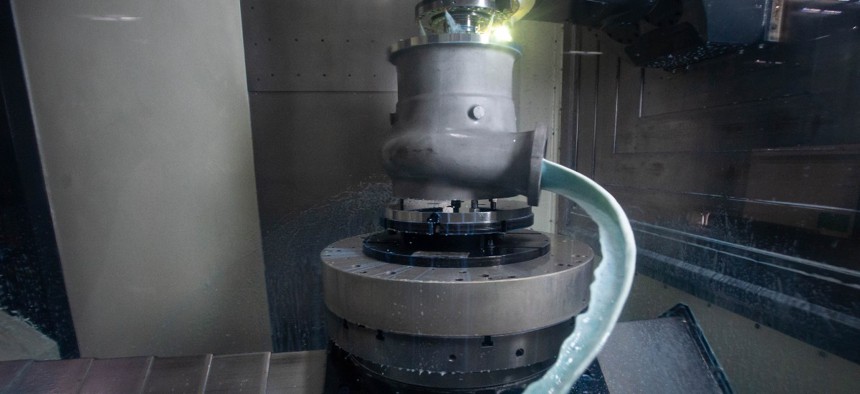L3Harris gets deeper into the supply chain with Aerojet in its fold

A RS-25 low pressure fuel turbo pump being machined at an Aerojet Rocketdyne facility in Canoga Park, California. MediaNews Group / Los Angeles Daily News via Getty Images
L3Harris Technologies' acquisition of Aerojet Rocketdyne has given the company more visibility into stressed supply chains and vendor capacity issues facing the defense industrial base.
L3Harris Technologies entered the solid rocket motor, engine and munitions product lines this summer through its $4.7 billion acquisition of Aerojet Rocketdyne.
That means L3Harris also now has more visibility into a supply chain network already stressed by the COVID-19 pandemic's disruptions, plus a demand landscape and world events that bring up questions regarding GovCon industrial capacity.
The chief executives of CACI International and Northrop Grumman spoke with investors on that topic during their quarterly earnings calls Thursday, and L3Harris CEO Chris Kubasik did the same with analysts on Friday.
Supply chains across the defense industrial base have tiers of companies whose products and parts feed into what larger prime contractors like L3Harris put together for their customers. With Aerojet in the fold, L3Harris will also become a merchant supplier to other weapon system makers that need items like motors and munitions.
As Kubasik put it during L3Harris' third quarter call, the challenges of adequate supply and production of munitions and rocket motors business become apparent the further they look down.
"We only have, in some cases, one or two certified suppliers of cases and igniters, and sometimes nozzles, so that is ultimately a choke point that we need to focus on as an industry and as a country," Kubasik added.
One tool being used to essentially jumpstart what Kubasik referenced is an approximately $200 million Defense Production Act agreement awarded to Aerojet in April. That funding will go toward the expansion and modernization of rocket propulsion systems that go onto missiles, missile interceptors, space launch vehicles and satellites.
"We'll use that as a framework. We're going to revitalize the business, and we'll use that for the other products that weren't necessarily covered by the DPA money," Kubasik said. "All of this will contribute to 2024 starting to see a ramp-up in the output, and I would expect to have noticeable improvements by the end of 2024 and then continuing into 2025."
But that agreement is one microcosm of a longer-term issue that many other industry leaders have highlighted: contraction across the defense industrial base over the past three decades.
"Money and focus needs to go to the sub-tier suppliers that feed into not only us, but other industry partners, generally through primes and then to the end users," Kubasik said.
Third quarter revenue of $4.9 billion was approximately 16% higher than the prior year period, figures that include organic sales of $4.36 billion and a 3% year-over-year growth rate. Segment operating income of $735 million showed a 15% increase on the bottom line.
L3Harris' updated guidance for 2023 has revenue in the range of $19.2 billion-to-$19.4 billion, after including Aerojet's contributions, with the organic outlook left at $18 billion-to-$18.3 billion. The company also sees segment operating income of $2.8 billion-to-$2.9 billion with Aerojet representing $120 million of that.


